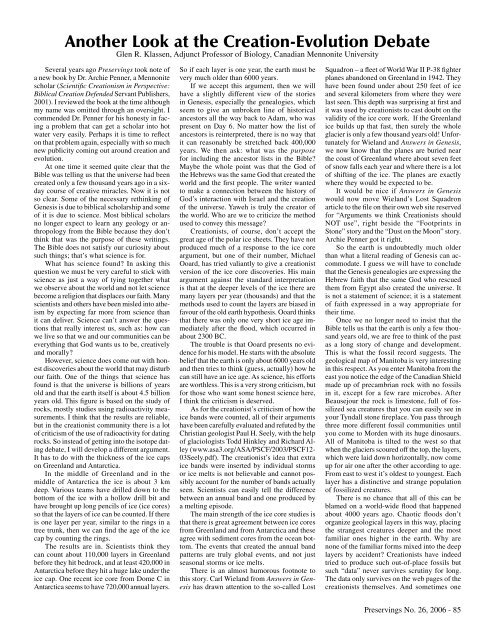Preservings $20 Issue No. 26, 2006 - Home at Plett Foundation
Preservings $20 Issue No. 26, 2006 - Home at Plett Foundation
Preservings $20 Issue No. 26, 2006 - Home at Plett Foundation
You also want an ePaper? Increase the reach of your titles
YUMPU automatically turns print PDFs into web optimized ePapers that Google loves.
Another Look <strong>at</strong> the Cre<strong>at</strong>ion-Evolution Deb<strong>at</strong>e<br />
Glen R. Klassen, Adjunct Professor of Biology, Canadian Mennonite University<br />
Several years ago <strong>Preservings</strong> took note of<br />
a new book by Dr. Archie Penner, a Mennonite<br />
scholar (Scientific Cre<strong>at</strong>ionism in Perspective:<br />
Biblical Cre<strong>at</strong>ion Defended Servant Publishers,<br />
2001). I reviewed the book <strong>at</strong> the time although<br />
my name was omitted through an oversight. I<br />
commended Dr. Penner for his honesty in facing<br />
a problem th<strong>at</strong> can get a scholar into hot<br />
w<strong>at</strong>er very easily. Perhaps it is time to reflect<br />
on th<strong>at</strong> problem again, especially with so much<br />
new publicity coming out around cre<strong>at</strong>ion and<br />
evolution.<br />
At one time it seemed quite clear th<strong>at</strong> the<br />
Bible was telling us th<strong>at</strong> the universe had been<br />
cre<strong>at</strong>ed only a few thousand years ago in a sixday<br />
course of cre<strong>at</strong>ive miracles. <strong>No</strong>w it is not<br />
so clear. Some of the necessary rethinking of<br />
Genesis is due to biblical scholarship and some<br />
of it is due to science. Most biblical scholars<br />
no longer expect to learn any geology or anthropology<br />
from the Bible because they don’t<br />
think th<strong>at</strong> was the purpose of these writings.<br />
The Bible does not s<strong>at</strong>isfy our curiosity about<br />
such things; th<strong>at</strong>’s wh<strong>at</strong> science is for.<br />
Wh<strong>at</strong> has science found? In asking this<br />
question we must be very careful to stick with<br />
science as just a way of tying together wh<strong>at</strong><br />
we observe about the world and not let science<br />
become a religion th<strong>at</strong> displaces our faith. Many<br />
scientists and others have been misled into <strong>at</strong>heism<br />
by expecting far more from science than<br />
it can deliver. Science can’t answer the questions<br />
th<strong>at</strong> really interest us, such as: how can<br />
we live so th<strong>at</strong> we and our communities can be<br />
everything th<strong>at</strong> God wants us to be, cre<strong>at</strong>ively<br />
and morally?<br />
However, science does come out with honest<br />
discoveries about the world th<strong>at</strong> may disturb<br />
our faith. One of the things th<strong>at</strong> science has<br />
found is th<strong>at</strong> the universe is billions of years<br />
old and th<strong>at</strong> the earth itself is about 4.5 billion<br />
years old. This figure is based on the study of<br />
rocks, mostly studies using radioactivity measurements.<br />
I think th<strong>at</strong> the results are reliable,<br />
but in the cre<strong>at</strong>ionist community there is a lot<br />
of criticism of the use of radioactivity for d<strong>at</strong>ing<br />
rocks. So instead of getting into the isotope d<strong>at</strong>ing<br />
deb<strong>at</strong>e, I will develop a different argument.<br />
It has to do with the thickness of the ice caps<br />
on Greenland and Antarctica.<br />
In the middle of Greenland and in the<br />
middle of Antarctica the ice is about 3 km<br />
deep. Various teams have drilled down to the<br />
bottom of the ice with a hollow drill bit and<br />
have brought up long pencils of ice (ice cores)<br />
so th<strong>at</strong> the layers of ice can be counted. If there<br />
is one layer per year, similar to the rings in a<br />
tree trunk, then we can find the age of the ice<br />
cap by counting the rings.<br />
The results are in. Scientists think they<br />
can count about 110,000 layers in Greenland<br />
before they hit bedrock, and <strong>at</strong> least 420,000 in<br />
Antarctica before they hit a huge lake under the<br />
ice cap. One recent ice core from Dome C in<br />
Antarctica seems to have 720,000 annual layers.<br />
So if each layer is one year, the earth must be<br />
very much older than 6000 years.<br />
If we accept this argument, then we will<br />
have a slightly different view of the stories<br />
in Genesis, especially the genealogies, which<br />
seem to give an unbroken line of historical<br />
ancestors all the way back to Adam, who was<br />
present on Day 6. <strong>No</strong> m<strong>at</strong>ter how the list of<br />
ancestors is reinterpreted, there is no way th<strong>at</strong><br />
it can reasonably be stretched back 400,000<br />
years. We then ask: wh<strong>at</strong> was the purpose<br />
for including the ancestor lists in the Bible?<br />
Maybe the whole point was th<strong>at</strong> the God of<br />
the Hebrews was the same God th<strong>at</strong> cre<strong>at</strong>ed the<br />
world and the first people. The writer wanted<br />
to make a connection between the history of<br />
God’s interaction with Israel and the cre<strong>at</strong>ion<br />
of the universe. Yaweh is truly the cre<strong>at</strong>or of<br />
the world. Who are we to criticize the method<br />
used to convey this message?<br />
Cre<strong>at</strong>ionists, of course, don’t accept the<br />
gre<strong>at</strong> age of the polar ice sheets. They have not<br />
produced much of a response to the ice core<br />
argument, but one of their number, Michael<br />
Ooard, has tried valiantly to give a cre<strong>at</strong>ionist<br />
version of the ice core discoveries. His main<br />
argument against the standard interpret<strong>at</strong>ion<br />
is th<strong>at</strong> <strong>at</strong> the deeper levels of the ice there are<br />
many layers per year (thousands) and th<strong>at</strong> the<br />
methods used to count the layers are biased in<br />
favour of the old earth hypothesis. Ooard thinks<br />
th<strong>at</strong> there was only one very short ice age immedi<strong>at</strong>ely<br />
after the flood, which occurred in<br />
about 2300 BC.<br />
The trouble is th<strong>at</strong> Ooard presents no evidence<br />
for his model. He starts with the absolute<br />
belief th<strong>at</strong> the earth is only about 6000 years old<br />
and then tries to think (guess, actually) how he<br />
can still have an ice age. As science, his efforts<br />
are worthless. This is a very strong criticism, but<br />
for those who want some honest science here,<br />
I think the criticism is deserved.<br />
As for the cre<strong>at</strong>ionist’s criticism of how the<br />
ice bands were counted, all of their arguments<br />
have been carefully evalu<strong>at</strong>ed and refuted by the<br />
Christian geologist Paul H. Seely, with the help<br />
of glaciologists Todd Hinkley and Richard Alley<br />
(www.asa3.org/ASA/PSCF/2003/PSCF12-<br />
03Seely.pdf). The cre<strong>at</strong>ionist’s idea th<strong>at</strong> extra<br />
ice bands were inserted by individual storms<br />
or ice melts is not believable and cannot possibly<br />
account for the number of bands actually<br />
seen. Scientists can easily tell the difference<br />
between an annual band and one produced by<br />
a melting episode.<br />
The main strength of the ice core studies is<br />
th<strong>at</strong> there is gre<strong>at</strong> agreement between ice cores<br />
from Greenland and from Antarctica and these<br />
agree with sediment cores from the ocean bottom.<br />
The events th<strong>at</strong> cre<strong>at</strong>ed the annual band<br />
p<strong>at</strong>terns are truly global events, and not just<br />
seasonal storms or ice melts.<br />
There is an almost humorous footnote to<br />
this story. Carl Wieland from Answers in Genesis<br />
has drawn <strong>at</strong>tention to the so-called Lost<br />
Squadron – a fleet of World War II P-38 fighter<br />
planes abandoned on Greenland in 1942. They<br />
have been found under about 250 feet of ice<br />
and several kilometers from where they were<br />
last seen. This depth was surprising <strong>at</strong> first and<br />
it was used by cre<strong>at</strong>ionists to cast doubt on the<br />
validity of the ice core work. If the Greenland<br />
ice builds up th<strong>at</strong> fast, then surely the whole<br />
glacier is only a few thousand years old! Unfortun<strong>at</strong>ely<br />
for Wieland and Answers in Genesis,<br />
we now know th<strong>at</strong> the planes are buried near<br />
the coast of Greenland where about seven feet<br />
of snow falls each year and where there is a lot<br />
of shifting of the ice. The planes are exactly<br />
where they would be expected to be.<br />
It would be nice if Answers in Genesis<br />
would now move Wieland’s Lost Squadron<br />
article to the file on their own web site reserved<br />
for “Arguments we think Cre<strong>at</strong>ionists should<br />
NOT use”, right beside the “Footprints in<br />
Stone” story and the “Dust on the Moon” story.<br />
Archie Penner got it right.<br />
So the earth is undoubtedly much older<br />
than wh<strong>at</strong> a literal reading of Genesis can accommod<strong>at</strong>e.<br />
I guess we will have to conclude<br />
th<strong>at</strong> the Genesis genealogies are expressing the<br />
Hebrew faith th<strong>at</strong> the same God who rescued<br />
them from Egypt also cre<strong>at</strong>ed the universe. It<br />
is not a st<strong>at</strong>ement of science; it is a st<strong>at</strong>ement<br />
of faith expressed in a way appropri<strong>at</strong>e for<br />
their time.<br />
Once we no longer need to insist th<strong>at</strong> the<br />
Bible tells us th<strong>at</strong> the earth is only a few thousand<br />
years old, we are free to think of the past<br />
as a long story of change and development.<br />
This is wh<strong>at</strong> the fossil record suggests. The<br />
geological map of Manitoba is very interesting<br />
in this respect. As you enter Manitoba from the<br />
east you notice the edge of the Canadian Shield<br />
made up of precambrian rock with no fossils<br />
in it, except for a few rare microbes. After<br />
Beausejour the rock is limestone, full of fossilized<br />
sea cre<strong>at</strong>ures th<strong>at</strong> you can easily see in<br />
your Tyndall stone fireplace. You pass through<br />
three more different fossil communities until<br />
you come to Morden with its huge dinosaurs.<br />
All of Manitoba is tilted to the west so th<strong>at</strong><br />
when the glaciers scoured off the top, the layers,<br />
which were laid down horizontally, now come<br />
up for air one after the other according to age.<br />
From east to west it’s oldest to youngest. Each<br />
layer has a distinctive and strange popul<strong>at</strong>ion<br />
of fossilized cre<strong>at</strong>ures.<br />
There is no chance th<strong>at</strong> all of this can be<br />
blamed on a world-wide flood th<strong>at</strong> happened<br />
about 4000 years ago. Chaotic floods don’t<br />
organize geological layers in this way, placing<br />
the strangest cre<strong>at</strong>ures deeper and the most<br />
familiar ones higher in the earth. Why are<br />
none of the familiar forms mixed into the deep<br />
layers by accident? Cre<strong>at</strong>ionists have indeed<br />
tried to produce such out-of-place fossils but<br />
such “d<strong>at</strong>a” never survives scrutiny for long.<br />
The d<strong>at</strong>a only survives on the web pages of the<br />
cre<strong>at</strong>ionists themselves. And sometimes one<br />
<strong>Preservings</strong> <strong>No</strong>. <strong>26</strong>, <strong>2006</strong> - 85
















